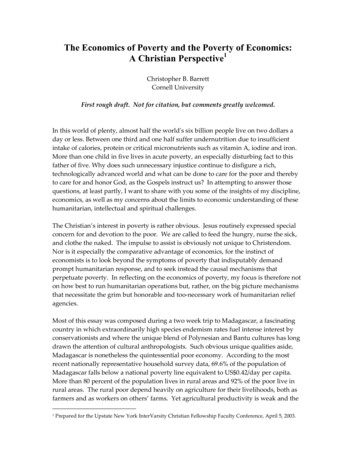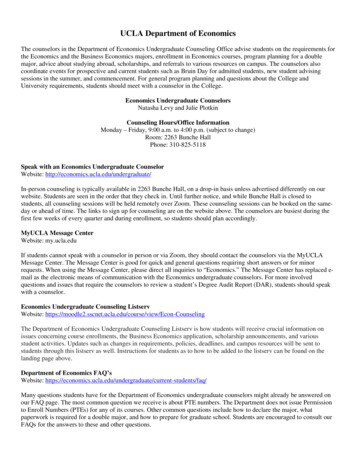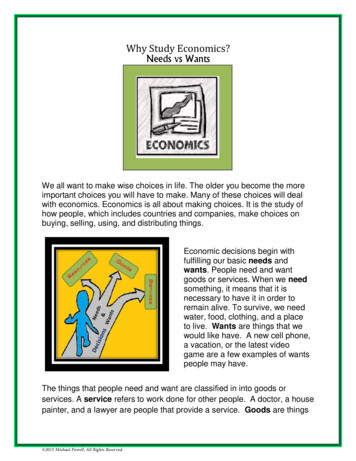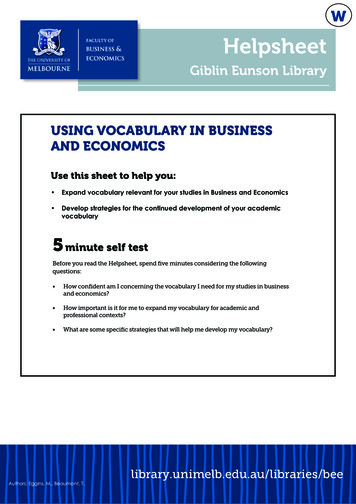
Transcription
Besanko Dranove Shanley SchaeferECONOMICS OFStrategySixth Edition
BUSINESSES IN THE BOOK3M Sounds.comAcuraAditya BirlaAdobe SystemsAdvanced MicroDevicesAetnaAir FranceAirbusAlamoAlcoaAldiAlfaAlienwareAlineaAll Nippon AirwaysAllegheny HealthEducation andResearch FoundationAmazonAmerican AirlinesAmerican Association ofPublic AccountantsAmerican BasketballAssociationAmerican CanAmerican FootballLeagueAmerican TobaccoAmfelAmicableContributorshipAmocoAngie’s ListAnheuser-BuschAOL Time WarnerAppleArcher DanielsMidlandArena Football LeagueArizona Iced TeaArmourAsahiAsea Brown BoveriASEA of SwedenAshland OilAsia BreweryAT&TAtlanta BravesAudiAudio TechniqueAverill PaintsAvis Rent-a-CarAvon ProductsAyre AcousticsB.A.TBank of AmericaBaringsBarnes and NobleBooksellersBass and CompanyBayer ChemicalBears StearnsBeatriceBell LabsBellKorBenettonBengenBertelsmann, A.G.Best BuyBest-LockBethlehem SteelBlizzard EntertainmentBlockbuster VideoBlue Cross Blue Shieldof MichiganBlue Cross of IllinoisBMGBMWBoeingBombardierBosch DensoBosidengBoston Beer CompanyBoston ConsultingGroupBritish AirwaysBritish MidlandsBritish PetroleumBritish TriumphBrown BoveriBudgetBurger KingBurroughsCablevisionCadbury SchweppesCallawayCanadian Pacific HotelsCanonCARACards AgainstHumanityCaremarkCargillCarnival CruiseCarrefourCartoon NetworkCaseCaterpillarCBSCeleraCemexCentral Pacific RailroadCentrilabChapparalCharles River BreedingLabsChattanooga PowderCompanyChevroletChicago BearsChicago BlackhawksChicago Board of TradeChicago BullsChicago CubsChicago MercantileExchangeChicago White SoxChina CentralTelevisionCincinnati EnquirerCincinnati RedsCincinnati SportsServiceCircuit CityCisco SystemsCisneros GroupCitigroupCNNCoca-ColaCollege of PhysiciansCollier’sColumbia/CBS RecordsComcastCompaqConocoConsolidated Edison
Consumer ReportsConsumers’ UnionContinental AirlinesContinental CanControladoraComercial MexicanaCostcoCraig’s ListCrayCrown HoldingsCrown, Cork and SealCSNDaewoo GroupDallas CowboysDallas MavericksDangjin SteelDannonDasaoziDaumDeBeersDECDeere & CompanyDel MonteDellDelta AirlinesDeltona CorporationDePaul Blue DemonsDerbyDHLDiamond WasteCompanyDigital EquipmentDIRECTVDisneyDKBDollarDollar GeneralDongfangaiyinDow ChemicalsDow CorningDr Pepper CompanyDunkin DonutsDuPontDynergyE-LandEADSEastman KodakeBayEdward HospitalEgon ZehnderInternationalElectroluxEmbraerEMIEmirates GroupEnronESPNEssel PropackEuropean MedicinesAgencyExxon MobilFacebookFairchildSemiconductorFairmontFamily DollarFDAFedExFinancial TimesFinley HospitalFischer-PriceFitch RatingsFive GuysFordFortinosFortnumFortune MagazineFountain BeverageDivisionFrance TelecomFrito-LayFuyoGalleries LafayetteGannettGatewayGatoradeGeisinger ClinicGeneral ElectricGeneral FoodsGeneral MillsGeneral MotorsGiantGilletteGlaxoSmithKlineGlobal RelationshipBankGMCGold Coast DogsGolden BooksGoldman SachsGoogleGordon RamsayHoldings Ltd.Green Bay PackersGreen GiantGrupo Carso SABGrupo ModeloGulf CooperationCouncilGymboreeHaidilaoHaier GroupHalembaHarley-DavidsonHarvey’sHazzard, Young andAtteaHeidrick & StrugglesHeinekenHenry Ford ClinicHertzHewlett-PackardHindalcoHome DepotHondaHouston Oil andMineralsHudepohlHuman GenomeSciencesHynixHyundai GroupIBMIkeaImperial ChemicalIndustriesIncyte GenomicsInditexInfinitiInfosysIntelInternational HarvesterInternational TinCouncilIntersparITTJ.C. PenneyJaguarJaipur RugsJames HardieJapan Craft BeerAssociationJBS SAJBS SwiftJCAHOJD PowersJeepJetBlue AirwayJimmy JohnsJohnson & JohnsonJP Morgan ChaseKangboKeeblerKelloggKenmoreKentucky FriedChicken(list continues at back of book)
ECONOMICSOF STRATEGY
This page is intentionally left blank
ECONOMICSOF STRATEGY6th EditionDavid Besanko / Northwestern UniversityDavid Dranove / Northwestern UniversityMark Shanley / University of Illinois at ChicagoScott Schaefer / University of Utah
VICE PRESIDENT & EXECUTIVE PUBLISHER George HoffmanEXECUTIVE EDITOR Joel HollenebeckEDITORIAL OPERATIONS MANAGER Yana MermelCONTENT EDITOR Jennifer ManiasCONTENT MANAGER Lucille BuonocoreSENIOR PRODUCTION EDITOR Anna MelhornMARKETING MANAGER Jesse CruzDESIGN DIRECTOR Harry NolanSENIOR DESIGNER Madelyn LesurePRODUCTION MANAGEMENT SERVICES Suzanne IngraoASSISTANT EDITOR Courtney LuzziEDITORIAL ASSISTANT Erica HorowitzCOVER PHOTO CREDIT Peter Barritt/ Super StockThis book was set in 10/12 Janson Text by Aptara , Inc. and printed and bound by QuadGraphics, Versailles. The cover was printed by Quad Graphics, Versailles.Copyright 2013, 2010, 2007, 2004, 2000, 1996 John Wiley & Sons, Inc. All rightsreserved. No part of this publication may be reproduced, stored in a retrieval system ortransmitted in any form or by any means, electronic, mechanical, photocopying, recording,scanning or otherwise, except as permitted under Sections 107 or 108 of the 1976 UnitedStates Copyright Act, without either the prior written permission of the Publisher, orauthorization through payment of the appropriate per-copy fee to the Copyright ClearanceCenter, Inc., 222 Rosewood Drive, Danvers, MA 01923, website www.copyright.com. Requeststo the Publisher for permission should be addressed to the Permissions Department, JohnWiley & Sons, Inc., 111 River Street, Hoboken, NJ 07030-5774, (201)748-6011,fax (201)748-6008, website http://www.wiley.com/go/permissions.Founded in 1807, John Wiley & Sons, Inc. has been a valued source of knowledge andunderstanding for more than 200 years, helping people around the world meet their needsand fulfill their aspirations. Our company is built on a foundation of principles thatinclude responsibility to the communities we serve and where we live and work. In 2008,we launched a Corporate Citizenship Initiative, a global effort to address the environmental,social, economic, and ethical challenges we face in our business. Among the issues weare addressing are carbon impact, paper specifications and procurement, ethical conductwithin our business and among our vendors, and community and charitable support.For more information, please visit our website: www.wiley.com/go/citizenship.Evaluation copies are provided to qualified academics and professionals for reviewpurposes only, for use in their courses during the next academic year. These copies arelicensed and may not be sold or transferred to a third party. Upon completion of thereview period, please return the evaluation copy to Wiley. Return instructions and afree of charge return shipping label are available at www.wiley.com/go/returnlabel.Outside of the United States, please contact your local representative.Library of Congress Cataloging-in-Publication DataEconomics of strategy/David Besanko . . . [et al.].—6th ed.p. cm.Includes index.ISBN 978-1-118-27363-0 (cloth)1. Strategic planning—Economic aspects. 2. Managerial economics. I. Besanko, David, 1955HD30.28.B4575 2013658.4'012—dc232012022657Printed in the United States of America10 9 8 7 6 5 4 3 2 1
PREFACEAlot has happened to the business landscape in the 20 years since my colleaguesand I began teaching business strategy at the Kellogg School of Management. Severalyears of steady but unspectacular economic growth culminated with the dot-combubble and a subsequent global recession. A broad-based recovery enabled many firmsin both the “old” and “new” economies to enjoy unprecedented profitability, only tosee profits dry up in the wake of a credit crunch and rising energy costs. The globaleconomy now seems on hold, as nations deal with long-term structural budget issues.Through it all, the strategy gurus have been quick to remind us that “the rules ofbusiness have changed.”1 The French have an apt rejoinder: Plus ça change, plus c’estla même chose. (The more things change, the more they stay the same.) Consider thefate of managers and investors who followed the latest fads of the last decade withoutpaying attention to tried and true economic concepts. Dot-com businesses sold identical products (pet food, toys, you name it) and discovered the perils of perfect competition. Movie studios followed the mantra of convergence, creating entertainmentsupergiants that failed to overcome the risks of extensive vertical integration. Banksignored basic economic principles of asymmetric information and loaned billions ofdollars to home buyers who could not repay them.These catastrophic mistakes confirm an important pedagogical message: there isa set of business principles that apply at all times to all sectors of the economy. Soundstrategic management requires mastery of these principles, not blind adherence to the“strategy du jour.” Managers who ignore these principles do so at their own peril.By their nature, principles are enduring. But they are not always well understood and,as a result, managers often fail to adhere to them. Michael Porter’s classic treatment ofthe principles of competition, Competitive Strategy, published until 1980, addressed thisproblem. Porter’s book provided an important illustration of how economic reasoning caninform practicing managers, particularly with regard to strategies for dealing with a firm’sexternal environment. But Competitive Strategy is not a textbook and does not provide thekind of economic foundation that we believe is required for deep strategic thinking.David Besanko, Mark Shanley, and I joined Kellogg in 1991, where we were immediately charged by Dean Donald Jacobs with revitalizing the strategy curriculum.(Scott Shaeffer joined Kellogg shortly afterward and joined the Economics of Strategywriting team for the third edition.) We searched for a textbook that might provide abroader and deeper economic foundation for strategic analysis. What we found wasat first discouraging. Most of the available texts in strategic management lacked disciplinary grounding. Few contained serious discussions of economics principles that areessential to strategy, such as economies of scale, transactions-cost economics, oligopolytheory, entry, commitment, incentives for innovation, and agency. Moreover, most ofthese books were targeted at more general audiences than what one finds at a businessschool such as Kellogg. We also learned that we were not the only ones struggling tov
vi Prefacefind an appropriate text for teaching business strategy. Indeed, the choice of a text forthe core strategy course appeared to be problematic at many business schools.Seeking to expand on Porter’s contributions to taking an economics-based approachto teaching strategy, we considered possible solutions. One possibility was to usea microeconomics text, which offers many real-world examples to demonstrate thepractical importance of economics. But this represents at best a compromise betweentraditional microeconomics and management strategy.In the years preceding our work on the first edition of Economics of Strategy, twoimportant books appeared. Sharon Oster’s Modern Competitive Analysis was remarkablefor its breadth, covering most of the topics that we had identified as important toteach in a management strategy class. Paul Milgrom and John Roberts’s Economics,Organization, and Management was remarkable for its depth. Milgrom and Robertsprovided a deep theoretical basis for understanding issues involving organization,incentives, and hierarchy. Our objective in writing Economics of Strategy was, inpart, to capture the breadth of Oster at a level of analysis approaching Milgrom andRoberts, while offering the kinds of illustrative examples that appear in both books.ORGANIZATIONOF THEBOOKIn preparing to write the sixth edition, I heard from many instructors that they preferred the organization of editions one through four. The sixth edition therefore revertsto form. Part One focuses on the boundaries of the firm; Part Two explores competition; Part Three covers positioning and sustaining advantage; and Part Four examinesthe interface between the theory of the firm, organization design, and business strategy.Despite these surface similarities to earlier editions, the sixth edition represents the mostsubstantial revision to date, with many substantial changes including the following: Several chapters have been consolidated. Economies of Scale and Diversification arenow combined in a single chapter. This reflects the logical connections between thetwo topics. Commitment and Dynamics of Competition have been consolidated intoa single chapter titled “Dynamics: Competing Across Time.” This chapter builds onstatic oligopoly models to explore the many ways that firms compete across time,including an expanded discussion of how industry structures evolve across time. Finally,I have combined the chapters on Sustaining Advantage and The Origins of Competitive Advantage, again reflecting the strong logical connections between the two. The chapter on Positioning has been dramatically streamlined. I have added a new chapter on Information and Value Creation. Heretofore, strategy books have emphasized that firms must differentiate themselves to thrive. Butthere has been little discussion of how firms inform consumers about their pointsof differentiation. This chapter describes how firms, markets, and certifiers discloseinformation about product attributes. This material helps explain the success ofGoogle, Facebook, and many Internet businesses. I expand on many important theoretical ideas and introduce some new ones. Readers will find detailed treatment of the Property Rights Theory of the Firm, BusinessGroups, Dynamic Learning Models, Endogenous Sunk Costs, Rent-Seeking Behavior,Disruptive Technologies, and other topics.As always, the book is liberally interspersed with real-world examples that bringthe economic models to life. The examples are drawn from around the world andcover business practice from the eighteenth century to the present day. I have updated
Preface viiexamples as needed and added many new examples including several that discuss business in China and India. I am especially grateful to doctoral student Bingyang Li fordeveloping the China examples. The business world is ever changing, and by the timeyou read this book, some references to organizations and individuals will be obsolete.I hope that the lessons learned from them will endure.My colleagues and I believe that this book can be used as a text either in a corestrategy course or in a business economics course that focuses on the economics ofindustry and the economics of the firm. In our 10-week strategy course for first-yearMBA students at Kellogg, we typically assign the following chapters:PrimerBasic PrinciplesChapter 2The Horizontal Boundaries of the FirmChapter 3The Vertical Boundaries of the FirmChapter 8Industry AnalysisChapter 9Strategic Positioning for Competitive AdvantageChapter 11Sustaining Competitive AdvantageIf we had an entire semester for our strategy course, we would add Chapter 5(Competitors and Competition), Chapter 10 (Information and Value Creation), andChapter 12 (Performance Measurement and Incentives). A more organizations-focusedcourse might replace Chapters 5 and 10 with Chapters 13 (Strategy and Structure)and/or 14 (Environment, Power, and Culture).The placement of the boundaries of the firm chapters (1–4) before the strategychapters (9–11) may strike some as atypical. However, it is not at all essential thatinstructors follow this ordering. As long as students understand the material in theEconomics Primer and the material on economies of scale and scope in Chapter 2,the strategy chapters can be taught before the chapters on the boundaries of the firm.Chapters 6 and 7 are the most “game theoretic” of the chapters in the book andare the most demanding for students with weaker economic backgrounds (thoughthe introduction to game theory in the Economics Primer coupled with material inChapter 5 should be sufficient for students to understand this material). Because students in our basic strategy course at Kellogg have not yet taken economics, we do notcover these chapters until the advanced class in Competitive Strategy. The material inChapters 12 and beyond does not depend on the material in Chapters 9–11, so thesechapters can be easily skipped without any loss in continuity.The book can also be used in a managerial economics course that emphasizescompetitive strategy and modern industrial organization. For a one-quarter course,we recommend use of these chapters:PrimerBasic PrinciplesChapter 2The Horizontal Boundaries of the FirmChapter 3The Vertical Boundaries of the FirmChapter 5Competitors and CompetitionChapter 6Entry and ExitChapter 7Dynamics: Competing Across TimeChapter 8Industry AnalysisChapter 9Strategic Positioning for Competitive AdvantageChapter 11Sustaining Competitive AdvantageFor a one-semester course, one could add Chapters 4 and 10.
viii PrefaceSUPPLEMENTARY MATERIALSThank you to Kevin Cochrane of College of the Desert for working with us to updateand revise the supplementary materials.Companion Web SiteA companion web site specific for this text contains the resources found here andmore. www.wiley.com/college/besankoInstructor’s ManualThe Instructor’s Manual provides several valuable resources that enhance eachchapter of the text, including a list of the chapter contents, a chapter summary,approaches to teaching the chapter, suggested Harvard Business School Case Studiesthat complement the chapter, suggested extra related readings, and answers to all ofthe end-of-chapter questions.PowerPoint PresentationsPowerPoint Slides including text art and lecture outlines for each chapter areprovided on the companion web site and can be viewed or downloaded to a computer.Test BankSample tests for each chapter contain a mix of multiple-choice questions varying inlevel of difficulty.ACKNOWLEDGMENTSMany individuals helped make the sixth edition of Economics of Strategy possible. We areespecially grateful to Jennifer Manias and Emily McGee of Wiley for the substantial workthey did in coordinating the development of the book. We want to also thank SuzanneIngrao of Ingrao Associates for so ably keeping the production of this book on track. Anda special thanks to Angie Malakhov for preparing the “Businesses in the Book.”Many of the improvements in the sixth edition are the result of comments receivedby instructors who used previous editions. My thanks to colleagues who so kindlypointed out the problem areas and suggested ways to improve them. I am also grateful for the comments we received from those who reviewed the book, including JedDeVaro, California State University, East Bay; Stephan F. Gohmann, University ofLouisville; Richard R. Hawkins, University of West Florida; Christine P. Ries, GeorgiaTech; Matthew Roelofs, Western Washington University; and, Frank C. Schultz II,University of California, Berkeley. I was pleased by the many substantive suggestionsthey offered for a book that has already been through five editions.David DranoveEvanston, IllinoisENDNOTE1A Google search of “the rules have changed” comes up with hundreds of business-relatedhits. I conduct a similar search for every edition and always discover a multitude of hits. I wonderhow they can be called rules if they are constantly changing.
BRIEF CONTENTSINTRODUCTION: STRATEGYANDECONOMICS 1ECONOMICS PRIMER: BASIC PRINCIPLES 9PART ONE: FIRM BOUNDARIES1234The Power of Principles: An Historical PerspectiveThe Horizontal Boundaries of the Firm 61The Vertical Boundaries of the Firm 98Integration and Its Alternatives 132PART TWO: MARKET5678ANDCOMPETITIVE ANALYSISCompetitors and Competition 165Entry and Exit 196Dynamics: Competing Across Time 226Industry Analysis 258PART THREE: STRATEGIC POSITION9101141ANDStrategic Positioning for Competitive AdvantageInformation and Value Creation 333Sustaining Competitive Advantage 363DYNAMICS293PART FOUR: INTERNAL ORGANIZATION121314Performance Measurement and Incentives 401Strategy and Structure 437Environment, Power, and Culture 470ix
This page is intentionally left blank
CONTENTSIntroduction: Strategy and Economics 1Why Study Strategy?Why Economics? 21The Need for Principles3So What’s the Problem? 3Firms or Markets? 6A Framework for Strategy 6Boundaries of the Firm 7Market and Competitive AnalysisPositioning and Dynamics 7Internal Organization 87The Book 8Endnotes 8Economics Primer: Basic Principles9Costs 10Cost Functions 10Total Cost Functions 10Fixed and Variable Costs 12Average and Marginal Cost Functions 13The Importance of the Time Period: Long-Run versus Short-Run CostFunctions 16Sunk versus Avoidable Costs 18Economic Costs and Profitability 19Economic versus Accounting Costs 19Economic Profit versus Accounting ProfitDemand and Revenues2020Demand Curve 20The Price Elasticity of Demand 21Brand-Level versus Industry-Level Elasticities24Total Revenue and Marginal Revenue Functions 24Theory of the Firm: Pricing and Output Decisions 26Perfect Competition 28Game Theory 31Games in Matrix Form and the Concept of Nash EquilibriumGame Trees and Subgame Perfection 34Chapter SummaryQuestions 36Endnotes 373235xi
xii ContentsPART ONE: FIRM BOUNDARIES 391The Power of Principles: An Historical Perspective 41Doing Business in 184041Business Conditions in 1840: Life Without a Modern Infrastructure 43Transportation 43Example 1.1: The Emergence of ChicagoCommunications 45Finance 45Production TechnologyGovernment 464446Example 1.2: Building National Infrastructure: The TranscontinentalRailroad 47Doing Business in 1910 48Business Conditions in 1910: A “Modern” InfrastructureProduction Technology 50Transportation 50Communications 50Example 1.3: Evolution of the Steel IndustryFinance 51Government52Doing Business Today495153Modern Infrastructure 54Transportation 54Communications 54Finance 54Production Technology 55Government 55Infrastructure in Emerging Markets56Example 1.4: The Gaizhi Privatization Process in China 56Three Different Worlds: Consistent Principles, Changing Conditions,and Adaptive Strategies 57Chapter Summary 58Questions 58Endnotes 592The Horizontal Boundaries of the Firm 61Definitions 61Definition of Economies of Scale 61Definition of Economies of Scope 63Scale Economies, Indivisibilities, and the Spreading of Fixed Costs 64Economies of Scale Due to Spreading of Product-Specific Fixed Costs 64Economies of Scale Due to Trade-offs among Alternative Technologies 65Example 2.1: Hub-and-Spoke Networks and Economies of Scope in the AirlineIndustry 67Indivisibilities Are More Likely When Production Is Capital IntensiveExample 2.2: The Division of Labor in Medical Markets69“The Division of Labor Is Limited by the Extent of the Market” 70Special Sources of Economies of Scale and Scope 71Density 71Purchasing 7168
Contents xiiiAdvertising 72Costs of Sending Messages per Potential ConsumerAdvertising Reach and Umbrella Branding 73Research and Development 73Physical Properties of Production 73Inventories 7472Complementarities and Strategic Fit 74Sources of Diseconomies of Scale 75Labor Costs and Firm Size 75Spreading Specialized Resources Too ThinBureaucracy 76Economies of Scale: A Summary 76The Learning Curve7677The Concept of the Learning Curve 77Expanding Output to Obtain a Cost AdvantageExample 2.3: Learning by Doing in Medicine7978Learning and Organization 80The Learning Curve versus Economies of ScaleExample 2.4: The Pharmaceutical Merger WaveDiversification 83Why Do Firms Diversify? 8382Efficiency-Based Reasons for DiversificationScope Economies 8483Example 2.5: Apple: Diversifying Outside of the BoxInternal Capital Markets 85Problematic Justifications for DiversificationDiversifying Shareholders’ Portfolios 87Identifying Undervalued Firms 87Reasons Not to Diversify 88Managerial Reasons for Diversification81848788Benefits to Managers from Acquisitions 88Problems of Corporate Governance 89The Market for Corporate Control and Recent Changes in CorporateGovernance 89Performance of Diversified Firms 90Example 2.6: Haier: The World’s Largest Consumer Appliance andElectronics Firm 92Chapter Summary 93Questions 94Endnotes 963The Vertical Boundaries of the Firm 98Make versus Buy99Upstream, Downstream 99Example 3.1: Licensing Biotechnology ProductsDefining Boundaries 101Some Make-or-Buy Fallacies 102Avoiding Peak Prices 103Tying Up Channels: Vertical ForeclosureExample 3.2: Employee Skills: Make or Buy?Reasons to “Buy” 106100104105
xiv ContentsExploiting Scale and Learning Economies 107Bureaucracy Effects: Avoiding Agency and Influence CostsAgency Costs 108Influence Costs 109Example 3.3: Disconnection at SonyOrganizational DesignReasons to “Make” 111111108110The Economic Foundations of Contracts 112Complete versus Incomplete Contracting 112Bounded Rationality 113Difficulties Specifying or Measuring Performance 113Asymmetric Information 114The Role of Contract Law 114Coordination of Production Flows through the Vertical ChainExample 3.4: Nightmares at Boeing: The 787 DreamlinerLeakage of Private Information 117Transactions Costs 118Relationship-Specific Assets 119Forms of Asset Specificity 119The Fundamental Transformation 120Rents and Quasi-Rents 120The Holdup Problem 121Example 3.5: Power Barges116115122Holdup and Ex Post Cooperation 123The Holdup Problem and Transactions Costs 123Contract Negotiation and Renegotiation 123Example 3.6: A Game of Chicken? Specificity and Underinvestment inthe Broiler Industry 124Investments to Improve Ex Post Bargaining Positions 124Distrust 125Reduced Investment 125Recap: From Relationship-Specific Assets to Transactions Costs125Summarizing Make-or-Buy Decisions: The Make-or-Buy DecisionTree 126Chapter Summary 127Questions 128Endnotes 1304Integration and Its Alternatives 132What Does It Mean to Be “Integrated?” 132The Property Rights Theory of the Firm 132Alternative Forms of Organizing Transactions 133Example 4.1: Vertical Integration in a Mountain ParadiseGovernance 136Delegation 136Recapping PRT 137Path Dependence 137Making the Integration Decision135138Technical Efficiency versus Agency Efficiency 138The Technical Efficiency/Agency Efficiency Trade-off139Example 4.2: Gone in a Heartbeat: The Allegheny Health Education and ResearchFoundation Bankruptcy 142
Contents xvReal-World Evidence142Double Marginalization: A Final Integration Consideration144Example 4.3: Vertical Integration of the Sales Force in the Insurance IndustryAlternatives to Vertical Integration 146Tapered Integration: Make and BuyExample 4.4: Franchise Heat in China146147Franchising 148Strategic Alliances and Joint VenturesExample 4.5: Toys “ R” Us Enters Japan145148149Implicit Contracts and Long-Term Relationships151Example 4.6: Interfirm Business Networks in the United States: The Women’s DressIndustry in New York City 153Business Groups 154Keiretsu 154Chaebol 156Business Groups in Emerging MarketsChapter SummaryQuestions 159Endnotes 160158PART TWO: MARKET5AND156COMPETITIVE ANALYSIS163Competitors and Competition 165Competitor Identification and Market DefinitionThe Basics of Competitor Identification166166Example 5.1 The SSNIP in Action: Defining Hospital MarketsPutting Competitor Identification into Practice 168Empirical Approaches to Competitor Identification 169Geographic Competitor Identification 169167Example 5.2: Defining Coca-Cola’s Market 170Measuring Market Structure 171Market Structure and Competition 172Perfect Competition 173Many Sellers 173Homogeneous Products 174Excess Capacity 174Example 5.3: The Bottom Drops Out on Cubs TicketsMonopoly 176Monopolistic Competition 177Demand for Differentiated Goods 178Entry into Monopolistically Competitive Markets175179Oligopoly 180Cournot Quantity Competition 180Example 5.4: Capacity Competition in the U.S. Beef ProcessingIndustry 181The Revenue Destruction Effect 184Cournot’s Model in Practice 185Bertrand Price Competition 185Example 5.5: Cournot Equilibrium in the Corn Wet Milling IndustryWhy Are Cournot and Bertrand Different?187186
xvi ContentsExample 5.6: Competition among U.S. Health Insurers188Evidence on Market Structure and Performance191Bertrand Price Competition When Products Are Horizontally Differentiated 189Price and ConcentrationChapter SummaryQuestions 192Endnotes 1946192191Entry and Exit 196Some Facts about Entry and Exit 197Entry and Exit Decisions: Basic Concepts 198Barriers to Entry 199Bain’s Typology of Entry Conditions 199Analyzing Entry Conditions: The Asymmetry RequirementExample 6.1: Hyundai’s Entry into the Steel Industry200Structural Entry Barriers 201Control of Essential Resources 201Economies of Scale and Scope 202Example 6.2: Emirates Air203Marketing Advantages of IncumbencyBarriers to Exit 205Entry-Deterring StrategiesLimit Pricing 207199205206Example 6.3: Limit Pricing by Brazilian Cement ManufacturersIs Strategic Limit Pricing Rational?208208Example 6.4: Entry Barriers and Profitability in the Japanese BrewingIndustry 210Predatory Pricing 211The Chain-Store Paradox 211Rescuing Limit Pricing and Predation: The Importance of Uncertaintyand Reputation 212Example 6.5: Predatory Pricing in the LaboratoryWars of Attrition214213Example 6.6: Wal-Mart Enters Germany . . . and ExitsPredation and Capacity ExpansionStrategic Bundling 216“Judo Economics” 217215Evidence on Entry-Deterring BehaviorContestable Markets 219An Entry Deterrence Checklist 220Entering a New Market 221218Preemptive Entry and Rent Seeking BehaviorChapter SummaryQuestions 223Endnotes 2247215222221Dynamics: Competing Across Time 226Microdynamics 227Strategic Commitment 227Strategic Substitutes and Strategic ComplementsThe Strategic Effect of Commitments 229228
Contents xviiExample 7.1: Loblaw versus Wal-Mart Canada230Tough and Soft Commitments 230A Taxonomy of Commitment Strategies 231The Informational Benefits of Flexibility 232Example 7.2: Commitment at Nucor and USX: The Case of Thin-SlabCasting 233Real Options 234Competitive Discipline 235Dynamic Pricing Rivalry and Tit-for-Tat Pricing236Example 7.3: What Happens When a Firm Retaliates Quickly to a Price Cut: PhilipMorris versus B.A.T. in Costa Rica 23
Advanced Micro Devices Aetna Air France Airbus Alamo Alcoa Aldi Alfa Alienware Alinea All Nippon Airways Allegheny Health Education and Research Foundation Amazon . these books were targeted at more general audiences than what one finds at a business school such as Kellogg. We











